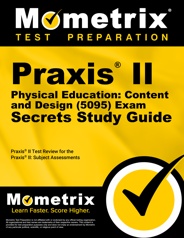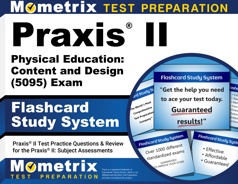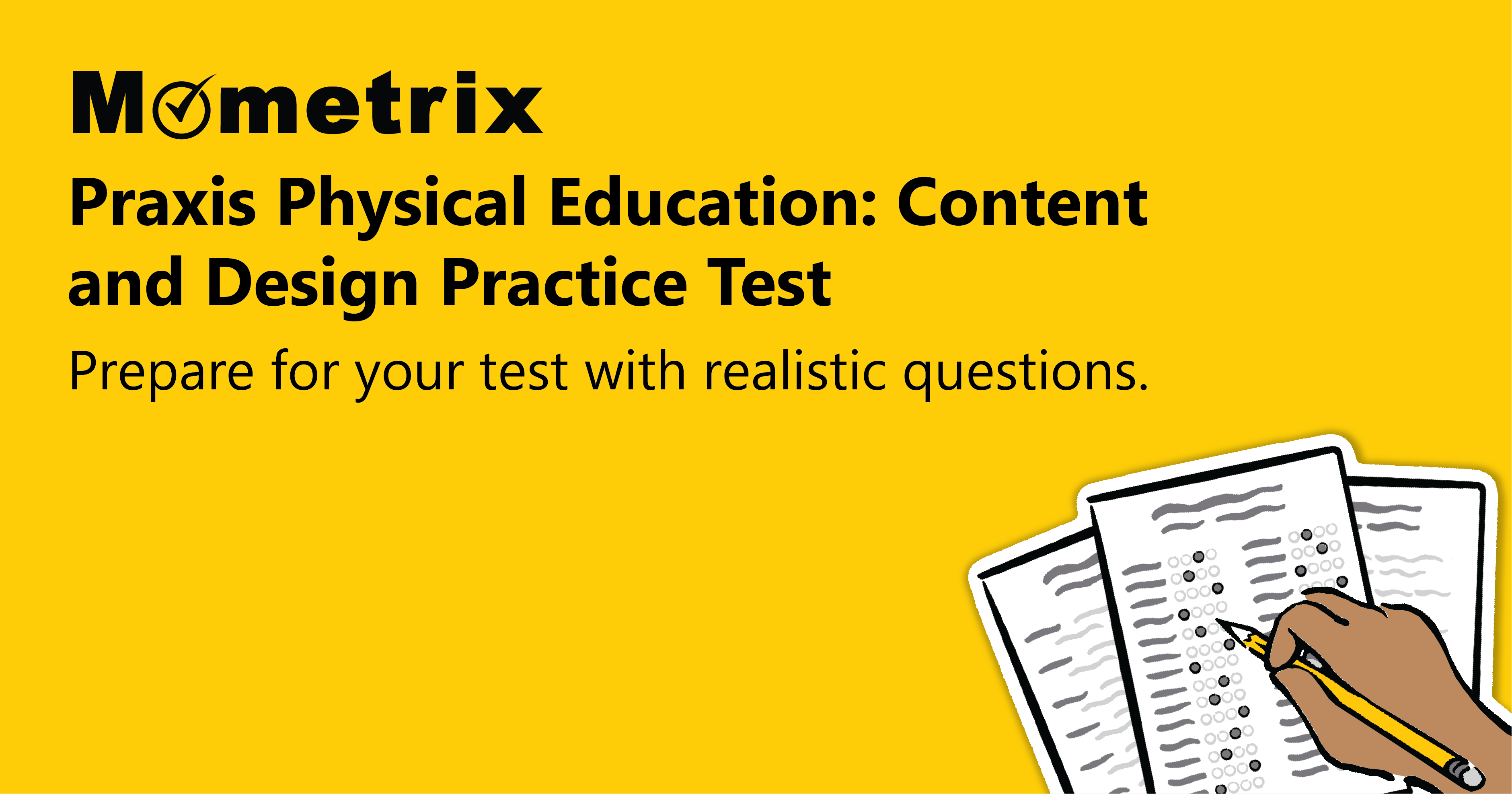The Praxis® Physical Education Content and Design exam is designed to measure the knowledge and skills that are essential for physical education teachers.
Click “Start Test” above to take a free Praxis Physical Education Content and Design practice test, and check out our premium-quality Praxis test prep resources by clicking the links below!
Exam Outline
The Praxis Physical Education Content and Design exam contains 90 selected-response questions and two constructed-response questions, and you will be given a time limit of two hours.
The exam is split into five content categories, which are designed to cover the various competencies and points of knowledge that a teacher should possess.
I. Content Knowledge and Student Growth and Development (27 questions)
The questions in this category assess your knowledge and abilities in the following areas:
- Terminology, concepts, applications, and principles of the basic sciences pertaining to motor skills
- Principles of biomechanics and kinesiology pertaining to motor skills
- Movement concepts
- Exercise physiology
- Anatomy and physiology
- Current and historical trends, developments, and issues in physical education
- Rules, skills, concepts, and strategies associated with various movement activities and games
- Liability and legal considerations related to using equipment, supervision, program selection, and class organization
- Effects of substance abuse on student health, behavior, and performance
- Learning and practice opportunities that are based on growth and motor development stages, characteristics, and needs of students
- Designing safe instruction by monitoring individual and group performance
- Developmental readiness to refine motor skills and movement patterns
- Perception in motor development
- Appropriate instruction related to cultures and ethnicities of students
- Appropriate professional support services and resources
II. Management, Motivation, and Communication (23 questions)
The questions in this category assess your knowledge and abilities in the following areas:
- Classroom management practices that create effective learning experiences
- Physiological and social factors that affect individual and group learning, cooperation, and participation
- Organization, management, and allocation of resources
- Motivating students to participate in physical activity
- Promoting positive relationships
- Developing and using an effective behavior management plan
- Effective verbal and nonverbal communication skills
- Appropriate instructional feedback in skills acquisition, motivation, and learning
- Communicating classroom management and instructional information
- Communicating in ways that show respect and consideration for students, parents, and colleagues
III. Planning, Instruction, and Student Assessment (23 questions)
The questions in this category assess your knowledge and abilities in the following areas:
- Teaching skillful movement, fitness, and physical activity via pedagogy, sociology, psychology, anatomy and physiology, exercise physiology, biomechanics and kinesiology, motor development, and motor learning
- Improving learning in physical education activities by sequencing motor skill activities and using movement concepts and strategies
- Providing feedback to enhance skill development
- Appropriate program and instructional objectives and goals
- Developing unit and lesson plans based on national, state, and local standards, as well as student needs
- Using teaching resources to design learning experiences
- Linking physical activity concepts to learning experiences
- Specific and general safety and injury-prevention guidelines for planning movement and fitness activities
- Assessing student skill performance and fitness
- Gathering data and assessing student learning in the affective and cognitive domains
- Types of assessments and assessment methods
- Ways of interpreting assessment results
- Involving students in self-assessment and peer assessment
- Assessment of individuals with disabilities
- Referral procedures under the IDEA and Section 504 of the Vocational Rehabilitation Act
IV. Collaboration, Reflection, and Technology (17 questions)
The questions in this category assess your knowledge and abilities in the following areas:
- Current educational issues that cross subject matter boundaries
- Integrating knowledge and skills from multiple subject areas in physical education
- Establishing productive relationships to support student growth and well-being
- Promoting various opportunities for physical activity in the school and community
- Using the reflective cycle to facilitate change in teacher performance, student learning, and instructional goals
- Using available resources to develop and grow as a reflective professional
- Designing, developing, and implementing student learning activities that integrate information technology
- Using technology to communicate, keep records, network, instruct, assess, present information, and enhance professional development
V. Instructional Design (2 questions)
The questions in this category assess your knowledge and abilities in the following areas:
- Fitness instruction
- Skill instruction
Check Out Mometrix's Praxis Study Guide
Get practice questions, video tutorials, and detailed study lessons
Get Your Study Guide
Registration
To register for the Praxis Physical Education Content and Design exam, you will need to create an online account with ETS. Through this account, you can submit an application to take the exam.
During registration, you will be asked to select the test-taking format (remote or at a testing center), test location (if you are taking the test at a testing center), and test date. You will also need to pay the $156 exam fee.
Test Day
In-person Testing
You should arrive at the testing center 15-30 minutes before the scheduled appointment. Once you arrive, you will be asked to provide a printed copy of your admission ticket and two forms of valid identification as soon as you arrive.
You will also be asked to store all personal items in a secure locker before entering the testing area.
Once the check-in process is complete and you are fully approved for testing, you will be led to the testing station and given a brief tutorial on the testing system.
Remote Testing
To take the exam remotely, you must use a laptop or desktop computer that has the ETS Secure Test Browser downloaded and installed on it. This is the browser you must use to take the exam. You will also need a functioning webcam, speakers, and a microphone.
When you check in to take the exam, the remote proctor will ask you to show proof of identification and to move your webcam around the room so that your testing area can be observed. Once the proctor has approved your testing area, they will walk you through the testing process and begin your exam.
How the Exam is Scored
Your Praxis Physical Education Content and Design exam score is based on the number of questions you answer correctly (your raw score). Your raw score is converted to a scaled score. The minimum scaled score you need to obtain to pass the exam varies from state to state, with most states requiring a minimum score of 169.
You should receive an official score report about five weeks after testing.
Check Out Mometrix's Praxis Flashcards
Get complex subjects broken down into easily understandable concepts
Get Your Flashcards
FAQs
Q
How many questions are on the Praxis Physical Education: Content and Design exam?
A
There are 92 questions on the exam.
Q
How long is the Praxis Physical Education: Content and Design exam?
A
The time limit for the exam is 2 hours.
Q
What is the passing score for the Praxis Physical Education: Content and Design exam?
A
The minimum passing score for this exam varies depending on the state you take the exam in.
Q
How much does the Praxis Physical Education: Content and Design exam cost?
A
The examination fee is $156.
Praxis is a registered trademark of Educational Testing Service, which is not affiliated with Mometrix Test Preparation and does not endorse this page.


